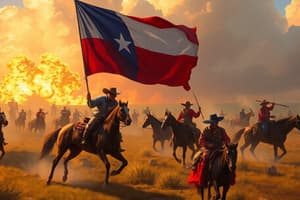Podcast
Questions and Answers
Which of the following BEST describes the concept of Manifest Destiny?
Which of the following BEST describes the concept of Manifest Destiny?
- The political strategy of establishing colonies overseas in the Pacific and Caribbean.
- The economic policy of westward expansion, focused on resource extraction and trade.
- The belief that the United States was divinely ordained to expand its power and civilization across North America. (correct)
- The social movement promoting equal rights for all peoples including native Americans and newly freed slaves.
What was a primary cause of the conflict between American settlers in Texas and the Mexican government?
What was a primary cause of the conflict between American settlers in Texas and the Mexican government?
- Disputes over land ownership and the boundary of the Rio Grande River.
- The forced conversion of American settlers to Catholicism.
- The American settlers' desire to establish trade relationships with Pacific islands.
- The Mexican government’s attempts to enforce its laws on slavery and immigration. (correct)
Which event marked the beginning of the Texas Revolution?
Which event marked the beginning of the Texas Revolution?
- Stephen F. Austin's initial migration of 300 families into Texas.
- Texas's formal request to the United States to be annexed as a new state.
- The Battle of San Jacinto, where General Santa Anna was captured.
- The declaration of Texas independence from Mexico by a group of American settlers. (correct)
Why did Presidents Jackson and Van Buren hesitate to annex Texas?
Why did Presidents Jackson and Van Buren hesitate to annex Texas?
What was the primary outcome of the Battle of San Jacinto?
What was the primary outcome of the Battle of San Jacinto?
What was the primary outcome of the Webster-Ashburton Treaty of 1842?
What was the primary outcome of the Webster-Ashburton Treaty of 1842?
Which of the following best describes the conflicting claims over the Oregon Territory?
Which of the following best describes the conflicting claims over the Oregon Territory?
How did the election of 1844 affect the expansion of the United States?
How did the election of 1844 affect the expansion of the United States?
What was the purpose of the Preemption Acts passed by Congress?
What was the purpose of the Preemption Acts passed by Congress?
What was the primary driving force behind the growth of urban centers in the West?
What was the primary driving force behind the growth of urban centers in the West?
What did the expansion of foreign commerce during this era primarily result from?
What did the expansion of foreign commerce during this era primarily result from?
What was the significance of Commodore Matthew C. Perry's mission to Japan?
What was the significance of Commodore Matthew C. Perry's mission to Japan?
What was the initial purpose of John Slidell's mission to Mexico?
What was the initial purpose of John Slidell's mission to Mexico?
Which of the following events directly triggered the start of the Mexican-American War?
Which of the following events directly triggered the start of the Mexican-American War?
What was the significance of the Bear Flag Republic in the context of the Mexican-American War?
What was the significance of the Bear Flag Republic in the context of the Mexican-American War?
What was a key term in the Treaty of Guadalupe Hidalgo?
What was a key term in the Treaty of Guadalupe Hidalgo?
What was the main point of contention regarding the Wilmot Proviso?
What was the main point of contention regarding the Wilmot Proviso?
What did the slogan 'Fifty-Four Forty or Fight!' refer to?
What did the slogan 'Fifty-Four Forty or Fight!' refer to?
Which of the following was NOT a typical danger encountered by travelers on the Overland Trails?
Which of the following was NOT a typical danger encountered by travelers on the Overland Trails?
What primary factor led to the dramatic population boom in California starting in 1848?
What primary factor led to the dramatic population boom in California starting in 1848?
Flashcards
Manifest Destiny
Manifest Destiny
The belief that the United States had a God-given right and mission to expand its territory across North America.
Texas
Texas
A region in present-day Texas that was originally part of Mexico, became independent in 1836, and joined the US in 1845.
Battle of San Jacinto
Battle of San Jacinto
The battle that resulted in the victory of the Texan forces led by Sam Houston, leading to Texas independence from Mexico in 1836.
Annexation
Annexation
Signup and view all the flashcards
Sam Houston
Sam Houston
Signup and view all the flashcards
Joint Resolution
Joint Resolution
Signup and view all the flashcards
Aroostook War
Aroostook War
Signup and view all the flashcards
Webster-Ashburton Treaty
Webster-Ashburton Treaty
Signup and view all the flashcards
Oregon Territory
Oregon Territory
Signup and view all the flashcards
49th Parallel
49th Parallel
Signup and view all the flashcards
James K. Polk
James K. Polk
Signup and view all the flashcards
Fifty-Four Forty or Fight!
Fifty-Four Forty or Fight!
Signup and view all the flashcards
Fur Traders
Fur Traders
Signup and view all the flashcards
Overland Trails
Overland Trails
Signup and view all the flashcards
Gold Rush
Gold Rush
Signup and view all the flashcards
Preemption Acts
Preemption Acts
Signup and view all the flashcards
Urban Frontier
Urban Frontier
Signup and view all the flashcards
Foreign Commerce
Foreign Commerce
Signup and view all the flashcards
Mexican-American War
Mexican-American War
Signup and view all the flashcards
Study Notes
Manifest Destiny and U.S. Expansion
- Background: Expansionists aimed for westward expansion to the Pacific Coast and southward into Mexico, Cuba, and Central America. This era saw the US acquiring islands in the Pacific and Caribbean. The concept of Manifest Destiny – the US's divine right to expand its power and influence across North America – became prevalent.
Texas Independence
- Mexican Independence: Texas's independence began with Mexico's independence from Spain in the 1820s. Mexico encouraged American settlement.
- American Settlement: American settlers, including farmers and slaveholders, rapidly outnumbered Mexicans in Texas by 1830.
- Conflict: Mexico's prohibition of slavery (1829) and religious conversion requirements were ignored. A strained relationship grew.
- Texas Independence Declaration: In 1836, Texans revolted against Mexican dictator Antonio López de Santa Anna, declaring independence. The battles of the Alamo and Goliad were significant turning points.
- Santa Anna's Capture: Sam Houston's forces captured Santa Anna at the Battle of San Jacinto, leading to a treaty recognizing Texas independence.
Texas Annexation
- Initial Rejection: Texas petitioned for annexation to the US, but presidents Jackson and Van Buren delayed due to opposition over Texas's slave status.
- Senate Rejection: President John Tyler, a southern Whig, worked for annexation but the Senate rejected it.
- Successful Annexation: Congress eventually passed a joint resolution annexing Texas in 1846.
Conflicts Over Texas, Maine, and Oregon
- Maine Dispute: Boundary disputes between Maine and British Canada existed. The Aroostook War, a conflict between lumber workers, ensued. The Webster-Ashburton Treaty resolved this conflict and settled the border between Canada and Minnesota.
- Oregon Dispute: The Oregon Territory was claimed by several nations, including the US, Great Britain and others. The Adams-Onis Treaty removed Spanish claims. Fur trading (Hudson Bay Company) was a key British interest.
- US Claim: The US claim was based on explorations like Lewis and Clark, and rising American population in the area (Oregon Trail).
- "Fifty-Four Forty or Fight!": President Polk used the slogan to advocate for American claims to the entire Oregon Territory. A treaty with Britain divided the territory along the 49th parallel.
Election of 1844
- Democratic Party Split: The Democratic party faced divisions over Texas annexation and the expansion of slavery.
- Polk's Victory: James K. Polk, a "dark horse" candidate committed to Manifest Destiny, emerged victorious and ran on the campaign plank "Fifty-Four Forty or Fight!"
- Polk and Clay: Henry Clay, the Whig candidate, shifted positions on Texas annexation, losing critical votes.
Settlement of the Western Territories
- Fur Traders' Frontier: Mountain men (fur traders) were early pioneers in the West, facilitating trade with Native Americans.
- Overland Trails: Pioneers on trails like the Oregon, California, Santa Fe, and Mormon Trails migrated westward. Disease and harsh conditions were major challenges.
- Mining Frontier: The Gold Rush of 1848 brought a surge of people to California, leading to rapid population growth. Chinese workers played a large role in these efforts.
- Farming Frontier: Squatters' rights were established through Preemption Acts in Congress, allowing settlement and purchase of public land.
- Urban Frontier: Western cities like San Francisco, Denver, and Salt Lake City grew due to railroads, mineral resources, and farming opportunities.
Foreign Commerce
- Increased Trade: The development of manufactured and agricultural goods contributed to growth in exports and imports.
- Shipping & Transportation Advancement: Regular shipping schedules, improved ships, and steamships decreased travel times across the Atlantic and Asia.
- Whaling Boom: The demand for whale oil fuelled a whaling industry from 1830 to 1860.
- Trade with Asia: American merchants traded with China for tea, silk, and porcelain. Commodore Perry's expeditions opened Japan.
Conflict with Mexico
- Slidell Mission: John Slidell sought to purchase California and New Mexico, as well as settle the border dispute (a failure).
- Rio Grande Dispute: Military conflict began over whether the border was the Rio Grande or the Nueces River.
- Mexican-American War Initiation: Armed conflict was provoked following a Mexican attack on American forces.
Mexican-American War's Impact
- Mexican Loss: The US emerged victorious.
- Treaty of Guadalupe Hidalgo: This treaty recognized the Rio Grande as the Texas border, secured California and New Mexico, and involved a significant $15 million payment to Mexico.
- Wilmot Proviso: This proposed ban on slavery in newly acquired territories, passed the House but not Senate, intensified sectional tensions.
Studying That Suits You
Use AI to generate personalized quizzes and flashcards to suit your learning preferences.




